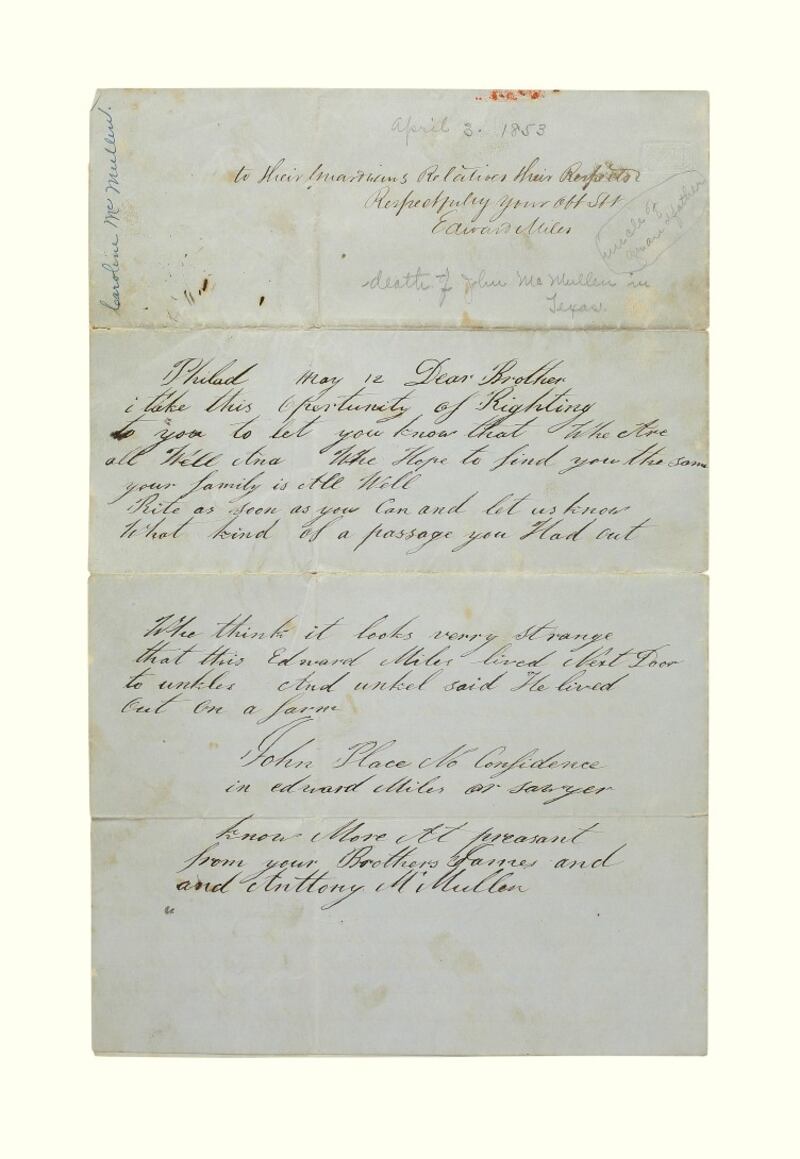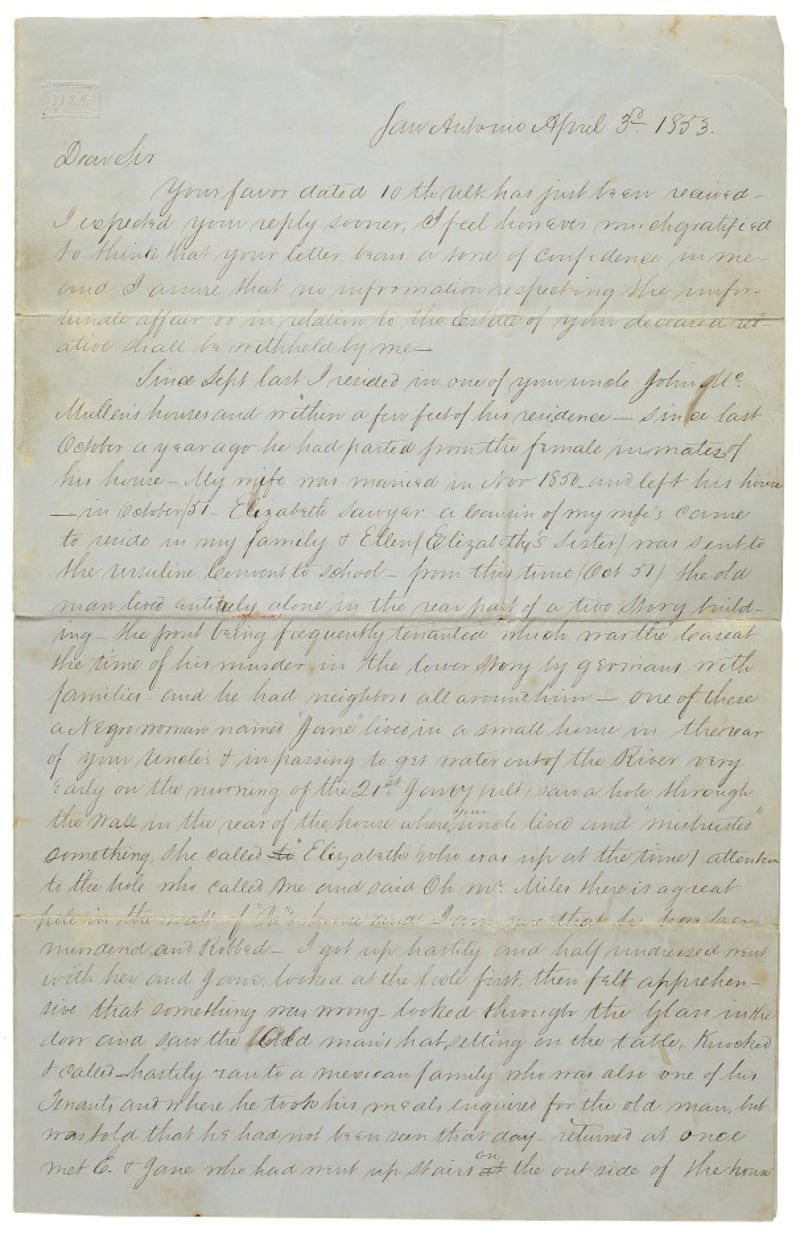In 1853 a trunk full of letters and an old black hat were abandoned outside the door of a courthouse in the Texan town of San Antonio de Béxar. It was all that remained of the possessions of one of the town’s wealthiest residents, an Irishman called John McMullen, who had been murdered in January of that year. According to Bexar county’s probate records for 1853, the trunk contained “papers and personal letters which are of no value”.
Having been declared valueless, the contents of that trunk were probably destroyed. But this week an archive of surviving letters from the McMullen estate goes under the hammer, at Sotheby’s of New York, with a guide price of $70,000 to $100,000.
Born in Donegal in 1785, John McMullen emigrated to the US, first to Baltimore, Maryland and then to Savannah, Georgia. In 1810 he married Esther Espadas Cummings, a widow with two children. She seems to have had Spanish connections, which may have contributed to the decision to move the family to the boom town of Matamoros, in newly independent Mexico, in the early 1820s.
Adopted child
There John and Esther adopted another child, a nine-year-old boy called José Antonio de Jesus, while one of Esther’s children from her first marriage married a Sligo man called James McGloin. Together, McMullen and McGloin established a merchandising business which quickly became successful.
The ambitious pair soon discovered that there was a bigger prize to be had. The Mexican government was giving large land grants, known as empresas, to anyone who would colonise the vast empty acres of Texas. There was just one stipulation: only Catholics could apply. With Irish immigrants arriving in New York in droves it must have seemed like a no-brainer – and by Christmas 1829, McMullen and McGloinn had settled some 200 Irish families on an area of prime land which stretched from the Nueces to the Medina rivers.

The plantation wasn’t a success. There were intermittent outbreaks of cholera, and occasional threats from local indigenous peoples. Many of the Irish colonists fled. And, as the 1830s wore on, political disturbances escalated into outright revolution as Texas asserted its right to self-governance. A flavour of the times can be had from one of the letters to be sold at Sotheby’s. Written to McMullen from an unknown colonist, it comments on the local elections of 1834 and complains that promised land grants have not been made.
Texan independence
Following Texan independence in 1836, McMullen seems to have given up on the colonisation idea; he sold most of his land to McGloin and settled at San Antonio, where he became a successful merchant and farmer. He kept a foot in politics, too, serving as temporary president of the general council of the new Texan republic. All the while he was buying up land and, by the mid-1840s, he was a wealthy man – a familiar and impressive figure, in his black cape and black hat, on the streets of San Antonio de Béxar.
It all came to a shocking end on the night of January 20th, 1853, when an unknown assailant entered McMullen’s home, bound and gagged him and slit his throat, leaving him to bleed to death.
After this horrific event McMullen’s nephew and namesake arrived in Texas from Pennsylvania to claim the estate, which was eventually split between the McMullens and McGloins. Many of the letters in the auction were written to the younger John McMullen by Jacob Waelder, a German-born lawyer and newspaper publisher who had settled San Antonio in 1852.
Most fascinating of all, however, is a letter from Edward Miles, the first administrator of the estate. Written shortly after the murder, it provides a hair-raisingly vivid eyewitness account of the older McMullen’s demise:
‘Hole in the wall’
“Since Sept last I resided in one of your uncle John McMullen’s houses and within a few feet of his residence . . . the old man lived entirely alone in the rear part of a two story building . . . and he had neighbours all around him –one of these a Negro woman named ‘Jane’ lived in a small house in the rear of your uncle’s & in passing to get water out of the River very early on the morning of the 21st of Janry (ult) saw a hole through the wall in the rear of the house where your uncle lived and ‘mistrusted’ something. She called Elizabeth’s (who was up at the time) attention to the hole who called me and said Oh Mr Miles there is a great hole in the wall of Pa’s house and I am sure he has been murdered and Robbed.”

Miles describes breaking down the door and trying to wake McMullen, without success. He continues: “The Mayor had handbills posted offering a reward for the Murderer – many persons were questioned – a great many enquiries were put on foot and some arrests were made, yet so far the affair is involved in Darkness, in mystery – his trunks had been broken open & pillaged or ransacked $68 in Silver was found in the Table Drawer – my own opinion is that the Murder’s object was money & I believe that in this he failed. Some think that the object was for papers – the old man was constantly improving his property, and was always hard run for money.”
Note of warning
Intriguingly, the final page of this letter bears a note of warning to John McMullen, signed by his brothers James and Anthony, and sent from Philadelphia on May 12th, 1853. “We think it looks very strange,” it reads, “that this Edward Miles lived Next Door to unkles And unkel said He lived out on a farm. John Place No Confidence in Edward Miles . . .”
John McMullen took due note, and was appointed executor of his uncle’s estate. But though local tradition insists that McMullen’s adopted son was the killer, this extraordinary historical murder mystery was never solved.
Sotheby’s, 1334 York Avenue, New York NY10021, sale of Fine Books and Manuscripts, June 13th 10am. See sothebys.com












